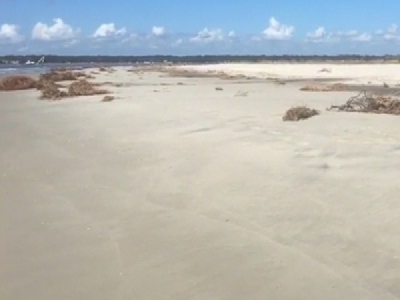
Posted on October 20, 2016
By Teresa Moss, The Island Packet
Hurricane Matthew did a number on Hilton Head Island’s beaches — accelerating erosion, wiping out dunes and forcing contractors to redo some of the restoration work that had been completed before the storm, town officials say.
The good news: Contractor Weeks Marine Inc. should be back on the job by Wednesday and is positioned to quickly return pumped sand that Matthew displaced. The bad news: It’s not yet clear how much this setback will add to the town’s $20.7 million maintenance project.
The town also is working on a plan to repair severely damaged areas that were not part of the original beach-renourishment project that began in June and is paid for through the town’s 2-percent fee charged to visitors staying in short-term lodging.
It took about 19 years to collect the money to pay for the current round of renourishment, which constituted the largest contract the town has ever awarded. If the cost increases, the Federal Emergency Management Agency might provide relief, but that funding could take more than a year to arrive, even if FEMA approves it, town manager Steve Riley said.
Mayor David Bennett was more confident FEMA would at least cover some of the cost of redoing work that has already been performed.
“I don’t know if you can take anything to the bank in the world of FEMA, but having that beach-management plan puts us in the position to be eligible,” Bennett said. “FEMA funding should cover about 75 percent of the costs.”
The town’s plan covers renourishment of eight miles of beach, five of which were completed before the storm, according to Scott Liggett, the town’s director of public projects and facilities. About two miles will need to be redone, he added.
Weeks Marine is to resume work near Coligny Beach by Wednesday. It will then progress north, toward Sonesta Resort. The work should go quickly, Liggett said, because although Hurricane Matthew swept away about 30 percent of the sand Weeks Marine had pumped onto the beach.
“After the project and before the storm, we had advanced the high tide line at Forest Beach to 100 feet,” Liggett said. “The storm cut that back by only 25 feet.”
Attempts this week to reach a Weeks Marine representative for comment were unsuccessful.
Once the two miles of beach are again renourished, normal operations will resume, according to a town news release. A revised construction schedule is expected soon.
As the town scrambles to get the project back on track, it also is considering what might be done about South Beach, a section in front of Sea Pines that was severely damaged by Hurricane Matthew but was not part of the original renourishment plan.
“There are areas there where the tide is right up against decks and pools,” Riley said. “There used to be a lot of beach here.”
Liggett said emergency permits could allow the town to push up sand to stabilize about 1,500 feet of beach, as the town waits for permitting needed to renourish anoter 4,500 feet nearby.
FEMA guidelines for will guide the town’s decision about how to proceed, Liggett said. For example, in some areas, sand washed off the beach but collected on a sandbar just past the low-tide mark, Liggett said, adding it is unlikely FEMA will cover such repairs.
“It is sand that is available to be pushed back higher on the beach profile,” Liggett said. “Federal funding is not a gravy train.”
Having Weeks Marine in the vicinity should allow the town to fix problems more quickly and inexpensively than a contractor staging work for the first time, Mayor Bennett said.
“We could already be completed with this project and we could have been waiting for six to nine months to get a new dredge contractor on the job,” Bennett said. “We have one ready to start immediately.”
With or without FEMA money, the town will have to pay for at least some of the repair, Bennett said.
“We will still be out of the pocket some, yes,” Bennett said. “But the beach is one of our major natural resources.”
Source: The Island Packet





